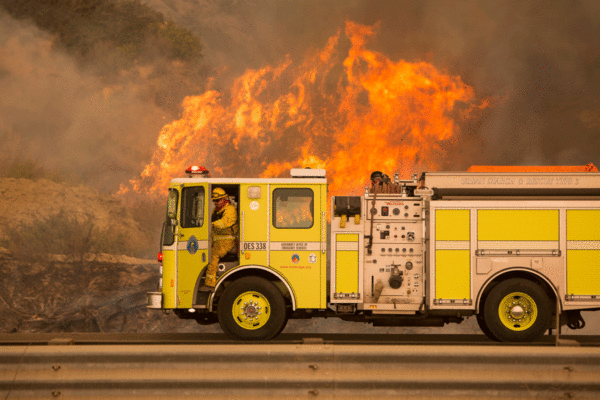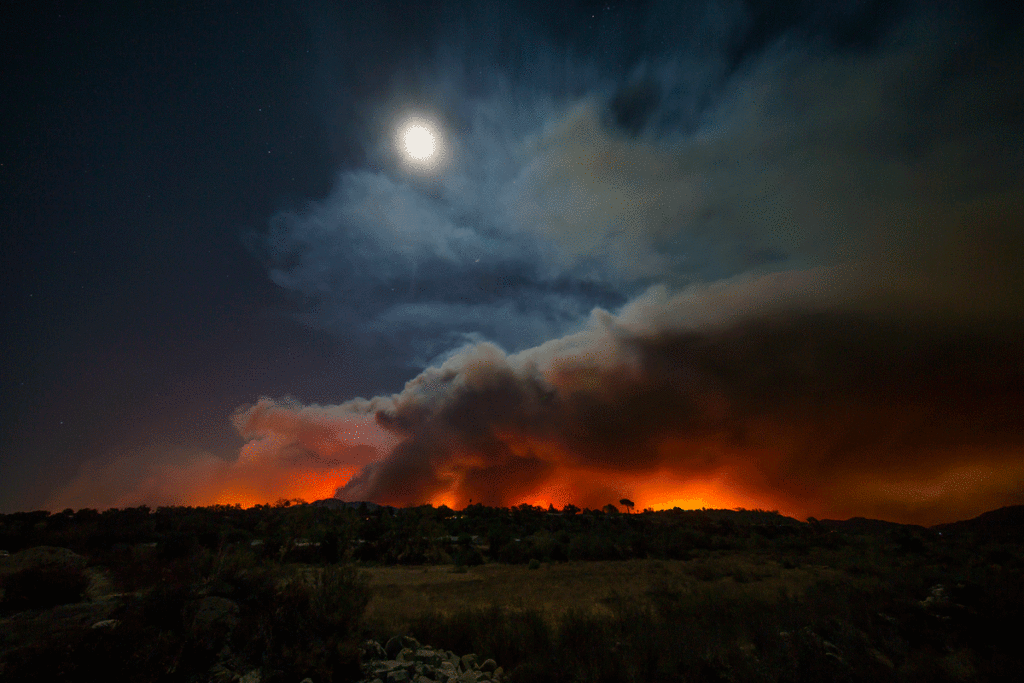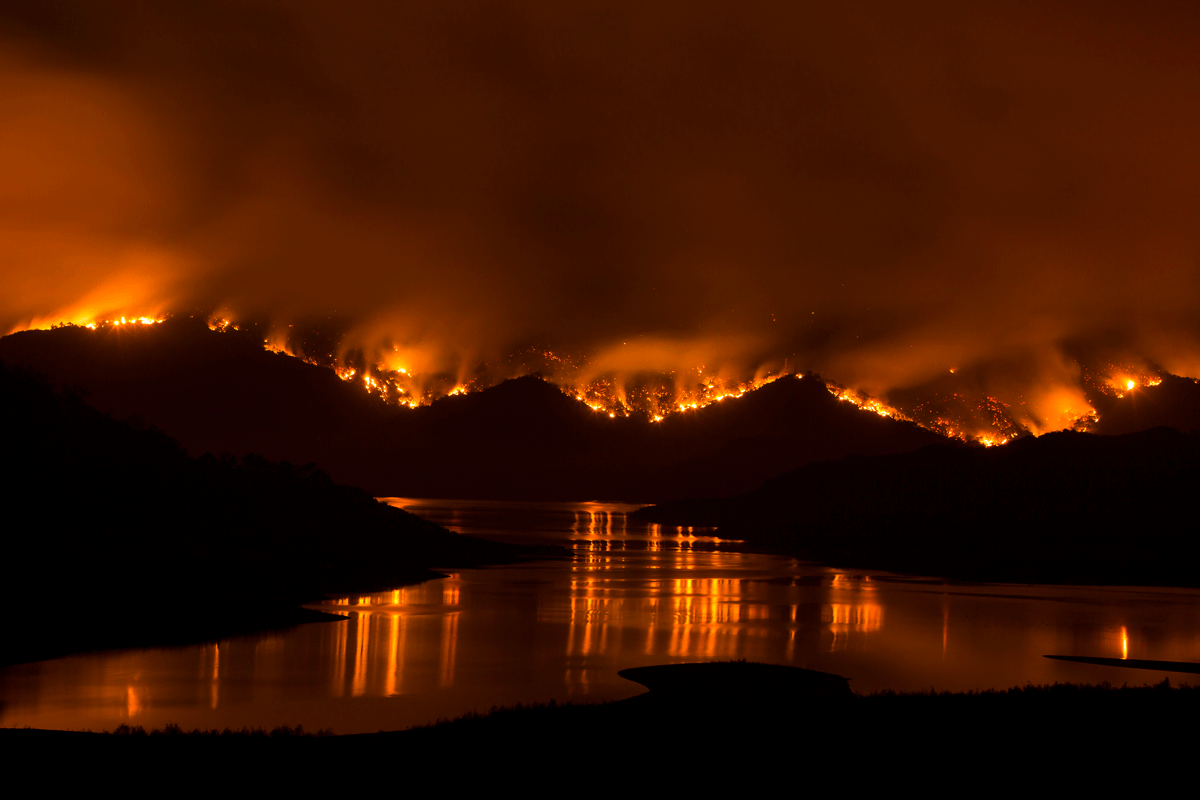FEATURE | By Kit Stolz and Michelaina Johnson
On the Firing Line
‘One smell of smoke and it all comes back’
On Dec. 4, Ojai awakened to a catastrophe: two fires surrounded the town, fueled by unusually powerful Santa Ana winds. Quickly the two blazes morphed into one and sprinted toward Ventura, Santa Barbara and Santa Paula, burning hundreds of structures in the process. Ojai residents evacuated to Buellton, the Bay Area, Los Angeles, Bakersfield and beyond, each returning to Ojai with their own story to tell.

A Governor’s Office of Emergency Services firetruck pulls up to a blaze adjacent to the 101 freeway near Highway 150 on Dec 6. Photo by Logan Hall.
Once the blaze had moved on, at least 171 homes were lost, and many more suffered significant damage. No life was left unscathed by this natural disaster.
While the fire was still raging, on January 9, massive mudslides devastated Montecito, killing at least 21 people and destroying 100 homes.
Then, on Jan. 12, the U.S. Forest Service declared the largest fire in California history completely contained at 281,893 acres. The Ojai Valley Land Conservancy lost about 65 percent, or approximately 1,500 acres, of their land to the fire. More than 152,000 acres burned in the Los Padres National Forest, making the Thomas Fire the third largest blaze to burn within the forest after the 1932 Matilija Fire and the 2007 Zaca Fire. A preliminary damage report by the Ventura County Agricultural Commissioner found that the inferno affected more than 10,289 acres of irrigated cropland and another 60,000 acres of rangeland with damage costs reaching an estimated $171,296,703.
While the igniters of the Thomas Fire were still under investigation as of late January, a confluence of the “perfect conditions for wildfires” made the size and ferocity of the record-breaking blaze possible, according to Bryant Baker, conservation director of the Los Padres Forest Watch. These factors include years of drought, a 300-day period of record dry days in Southern California, a statewide heatwave in the fall and the warmest December on record along California’s southern coast.
While these temperature-related records are cause for alarm, Jon Keeley, fire expert and research scientist at the U.S. Geological Survey, is quick to point out that “those who conten d that global warming accounts for the Thomas Fire are distracting our attention from the more significant factors, such as the anomalous Santa Ana wind event and land planning decisions that put increasing populations into dangerous watersheds.”
The scientific explanations, dates, statistics and numbers tell one story. The tens of thousands of people in Ojai affected by the fire tell another. The following pages recount local residents’ experiences with the Thomas Fire.
JIM CHURCHILL
The Ojai Quarterly talked to Jim Churchill at the Farmers’ Market on a recent Sunday morning. Churchill Orchard has been selling organic citrus — including the Pixie tangerines Jim and his partner Lisa Brenneis first retailed — for many years, but this was the first time they had been to the market in Ojai since the Thomas Fire.
OQ: You compared the impact of the Thomas Fire on Ojai to what happened to New York after 9/11. Why?
JC: The community is in shock. Everybody knows somebody who was devastated. It’s most awful for people who have been burned or flooded, but the community as a whole has been traumatized. I don’t see a quick recovery. I see people in town walking around looking shell-shocked.
OQ: You mentioned that you and your wife had done a little “disaster tourism” around town.
JC: We went up Koenigstein Road in Upper Ojai. We wanted to see what it looked like. I take fruit to Santa Paula every day to be packed, so I had some idea, but you can’t really understand the devastation until you get off the highway. Lisa and I also drove up Highway 33 to see what it looked like at the higher elevations. South of Rose Valley, but north of Wheeler Campground, there’s a place where the highway is undercut, and it’s a steep long drop and it looks like it’s going to be really difficult to put that back together. We went out to Matilija Canyon, and saw Jeff and Karen Hesli at their place working frantically with a crew of volunteers to prepare for mudslides. How awful is that, to have struggled to save their home from a firestorm, which they did by dint of great effort, only to have to immediately turn around and get ready for a deluge.
OQ: What lessons can we learn from this disaster?
JC: Our friend David White (a leader in the Ojai permaculture movement, and the founder of the Center for Regenerative Agriculture) says that it’s time to modify the building code to approve fire-resistant building materials and buildings. We saw that adobe and super-adobe buildings at the Ojai Foundation survived the fire, whereas most conventional structures did not. Despite a lot of advocacy, I think it’s going to be quite a struggle. The Ventura County Building and Safety Department doesn’t seem to respect opinions from outside their department.
OQ: Did you have any personal or business losses?
JC: We lost 50 percent of our avocado crop immediately to the winds. The fire didn’t reach us directly, but we know it’s not going to be a good year for our citrus.
OQ: Any local heroes come to mind, during the fire?
JC: In Ojai, Dave West (of Westridge Markets) stayed open through the fires, even though he had to recruit members of his own family to do it, and that was a great and useful gift to the community. The folks at Beacon (Jennifer and John Wheir) opened despite bad air quality. Since the fire Liz Haffner at Azu has been working very hard to foster connections in the community, and bring business back to Ojai.
OQ: How’s the Farmers’ Market looking to you?
JC: I’ve seen more vehicles in town today, but the market still feels light. A lot of sellers, from places like Cuyama and Goleta, simply can’t get here, because Highway 101 and Highway 33 are closed.

Looking across the riverbottom, from Highway 150 toward Mira Monte, an ominous glow could be seen behind Ojai on Dec. 4 not long after the fire started. Fire photos by Logan Hall
KARIN DRON
The Thomas Fires destroyed Karin Dron’s historic stone house and family compound in Sisar Canyon, about four miles off the road that runs past Summit School in Upper Ojai. The stone house, built in the 1930s, was home to Karin, her late husband Boyd Dron, and three daughters, for decades.
Despite knowing that her family home had been destroyed by fire on Monday, Karin — a rounds singer, contra dancer, and massage therapist who has lived in Ojai since marrying her late husband in the 1970s — worked frantically with a couple of friends and relatives to save the “Dronhame” (family home) on Gridley Road, not far from the Hermitage Ranch in the East End, from the fires during that fateful week in December.
A fire photojournalist mentioned that a “strike team” was coming to help, but no help arrived. Firefighters on Gridley Road told her that the home was “undefendable” and drove away. With Rick Bisaccia and three others, she spent hours clearing brush and wetting exposed wood, leaving only when the fire began to surround them. She returned the next morning, fearing the worst, and discovered that her house, which had nearly been destroyed in another major fire in 1948, had survived. Most of the surrounding landscape and secondary buildings in the area were vaporized.
Karin talked to the Ojai Quarterly, and also told her story as part of a performance on the Thomas Fire put on at Kim Maxwell’s studio on three dates this past January. This is a blend of her performance and an interview.
OQ: How are you feeling?
KD: Emotionally exhausted. There’s just been so much heartbreak. My husband died in 2014. My best friend died five months later, of cancer. I lost my family home, where we raised our daughters and where we lived for 37 years.
At the same time part of me feels I have no right to complain. I still have a house I inherited after all, on Gridley. I have close friends, like Coline Tabrum, who have lost everything.
But it just keeps coming. The fire burned the water line, and then the rains (in January) disrupted the line again, and buried my septic tank. It’s a very old house, and it’s a constant struggle to keep it liveable in these conditions. The temporary water line is hanging by a thread. I’m on the edge of losing it at all times. I don’t have insurance. If one more person asks me why I’m not OK, given that I still have a house, I may break down. I’m just not OK. I evacuated after the fire, and slept a little better when I was away, but when I slept in the house again, I found myself waking up at 4:30 a.m., with my heart pounding, with visions of fire.
OQ: Your house in Sisar Canyon — on a 40-acre in-holding, surrounded by the Los Padres National Forest — was pretty special. Give us an idea of what it was like.
KD: I remember building that house in Sisar Canyon, rock by rock, beginning with the hand digging of the foundation trenches. I was eight months pregnant, but there was no holding me back. So many people became part of the counterculture community we created up there, and shared our dream of living close to the earth. I remember splashing into the icy cold spring-fed pool on a hot Ojai day. I remember the children climbing into the cherry tree to gather the delicious fruit the birds had missed, and the fig tree spreading its protective branches over the shimmering trout-fed pool. I remember celebrating birthday parties, where visiting little girls in shiny, patent leather shoes and frilly dresses were at a definite handicap compared to our hiking-boot-and-Levi’s-clad mountain goat daughters. I remember the girls scampering up the nearly vertical hill to our garden, with the baby goats and the heart-opening view of the Topa Topas.
OQ: I understand you haven’t been back to the Sisar Canyon stone house.
KD: No. I haven’t been able to go back. I’ve seen pictures, though, and oh my God, the destruction. We called it the “could-withstand-all” house, because it was built of rock, and had a metal roof, and wooden shutters with metal on the outside. But when the fires came the guys who lived up there had to evacuate. A tree caught fire and fell through the skylight. The fire cracked the mortar, the walls began to crumble and the roof’s timber burned. It’s distorted almost beyond recognition now. Gone are all the tiny houses on the property, the workshop, the massage room, the infrastructure. The bridge across the creek burned, and so the physical connection to all that is gone too. How do you reconcile a pile of rubble with the family home of 37 years? How do you say goodbye to a life’s journey?
OQ: Are you going to rebuild the Sisar Canyon property?
KD: I don’t think I can. I just don’t think I’m the person to do it. It’s still amazing to me that (my husband) Boyd was able to make it possible for us to live in that kind of wild nature so close to this community, and yet so isolated, for so many years. And when I start thinking about it, and excavating the stories about our life up there, it’s like losing Boyd all over again.
OQ: Do you worry about not being able to recover emotionally from these disasters?
KD: People tell you that you will get beyond the trauma, but they don’t tell you that you will be a changed person. We all want to move on, to have fun, but it doesn’t take much to be overwhelmed all over again. One smell of smoke, and it all comes back. When I drive to Upper Ojai I look around and think oh my God, there’s no escaping it, it’s everywhere. It’s horrendous. For me it’s an inkling of what it must be like to go through a war in your community, with devastation that continues day after day.
OQ: Do you see a way out of our collective grief?
KD: From my house I can look out and see this one palm tree, a non-native planted by some bird God knows when, that didn’t completely burn, and it’s putting out a new palm. My eye goes to the green, and I know that it will come back. And I have heard from so many people who knew the Sisar Canyon community we had, and loved the serenity and beauty of that place. The coming together of the Ojai community has been incredible.
OQ: What about fire? How do you feel about fire these days?
KD: In my singing group we used to sing a song to fire, thanking it for its warmth, its beauty, the way it brought people together. It’s a beautiful song, written by Marilyn Power Scott.
Thank you Fire, for your beauty
Thank you Fire, for your sweet sweet song
Thank you Fire, for your warmth and your light
And for your dance of joy in the cool, cool night.
Marilyn wrote that song around a campfire in Wheeler Campground in 1999, and we still sing it, but not as much as we once did. We always saw the duality of fire in Sisar Canyon — its beauty and its threat.


Leave A Comment